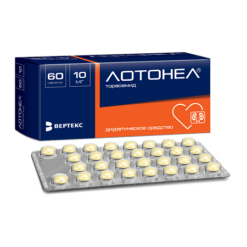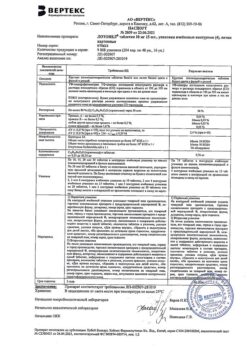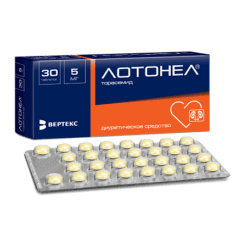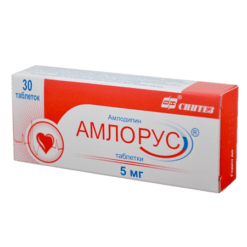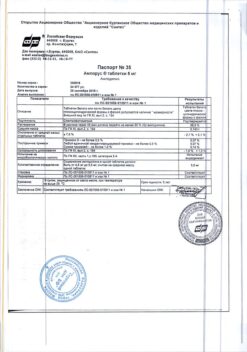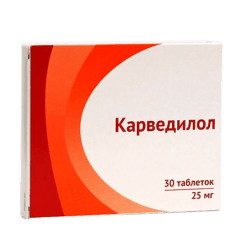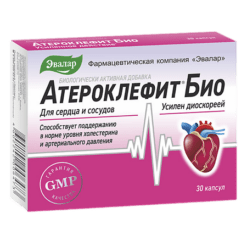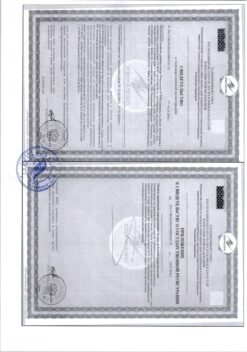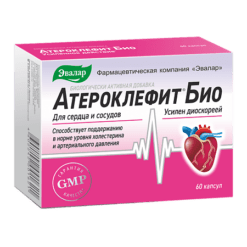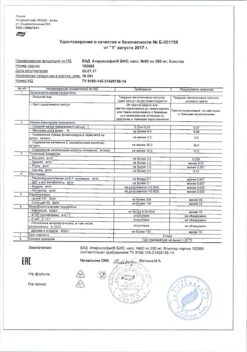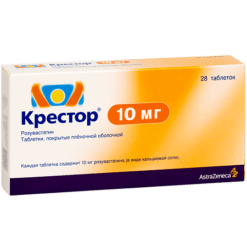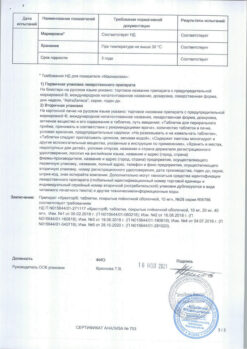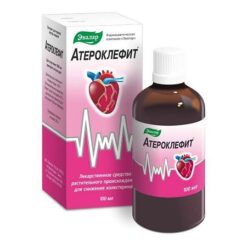No products in the cart.
Raenom, 7.5 mg 56 pcs.
€21.93 €19.00
Out of stock
(E-mail when Stock is available)
Description
Ivabradine is a drug that slows the heart rhythm. The mechanism of action of ivabradine is selective and specific inhibition of If channels of the sinus node, which control spontaneous diastolic depolarization in the sinus node and regulate heart rate (HR).
Ivabradine has a selective effect on the sinus node without affecting pulse conduction time along the atrial, atrial-ventricular and intraventricular conduction pathways and on myocardial contractility and ventricular repolarization. Ivabradine can also interact with Ih, retinal channels similar in structure to //channels of the heart. They are involved in the mechanisms of temporal adaptation of the visual perception system by changing the retinal response to bright light stimuli.
In provoking circumstances (e.g., a sharp change in light intensity in the visual field area), partial inhibition of If channels by ivabradine results in the phenomenon of changes in light perception (photopsia). Photopsia is characterized by a transient change in brightness in a limited area of the visual field (see section “Side effects”).
The main pharmacological effect of ivabradia is a dose-dependent decrease in heart rate. The dose-dependent HR decrease has been analyzed by gradually increasing the dose of ivabradia up to 20 mg twice daily and shows the tendency to reach a “plateau” effect (no increase of therapy effect with further increase of the dose), which reduces the risk of bradycardia (HR <40 bpm) (see section "Adverse drug effect").
In using the drug in the recommended doses, the degree of HR reduction depends on its initial value and is about 10-15 bpm at rest and during physical activity, as a result of which the heart rate and myocardial oxygen demand decrease. Ivabradine has no effect on vitric conduction, myocardial contractility (no negative inotron effect) and the process of ventricular repolarization.
In clinical electrophysiological studies ivabradine had no effect on atrial-ventricular or intraventricular conduction time and corrected QT intervals. In studies in patients with left ventricular dysfunction (left ventricular ejection fraction (LVEF) 30-45%) it has been shown that ivabradine has no effect on myocardial contractility. It was found that ivabradine at a dose of 5 mg 2 times a day improved the values of stress tests after 3-4 weeks of treatment.
The efficacy was also confirmed for the dose of 7.5 mg 2 times 15 days. An additional effect when the dose was increased from 5 mg to 7.5 mg 2 times a day was established in a comparative study with atepolol. Exercise time increased by about I minute after 1 month of using ivabradine in a dose of 5 mg 2 times a day, and after an additional 3-month course of taking ivabradine in a dose of 7.5 mg 2 times a day orally, a further increase of 25 seconds in this parameter was noted.
The antianginal and anti-ischemic activity of ivabradine was also confirmed in patients aged 65 years and older. The efficacy of ivabradine at the doses of 5 mg and 7.5 mg twice daily was observed in all exercise test parameters (total exercise duration, time to limiting angina attack, time to onset of angina attack and time to ST-segment depression by 1 mm) and was accompanied with reduction of angina attack frequency by approximately 70%.
The use of ivabradine 2 times daily provided consistent therapeutic efficacy for 24 hours. In patients taking ivabradine additional efficacy in all exercise test values was shown when added to the maximum dose of atenolol (50 mg) at the onset of its therapeutic activity (12 hours after oral administration).
The efficacy of ivabradine has not improved when added to the maximum dose of amlodinine at the start of the therapy (12 hours after oral administration), whereas at the peak of amlodinine activity (3-4 hours after oral administration) ivabradine has been demonstrated to be more effective.
In studies of the clinical efficacy of ivabradine its therapeutic effect was fully maintained for 3-4 months of therapy. There were no signs of decreased efficacy during treatment and no “withdrawal” syndrome was observed after discontinuation of treatment. Antianginal and antiischemic effects of ivabradine were associated with both dose-dependent HR reduction and a significant reduction in work product (HR x systolic blood pressure) both at rest and during exercise.
The effects on blood pressure (BP) and total peripheral vascular resistance (TPR) were insignificant and clinically insignificant. Sustained HR slowing was noted in patients who had been taking ivabradine for at least 1 year. No effect on carbohydrate metabolism and lipid profile was observed.
In patients with diabetes mellitus the efficacy and safety of ivabradine were similar to those in the general population. No differences were found between groups of patients who received ivabradine against standard therapy and patients with stable angina and left ventricular dysfunction (LVEF less than 40%), 86.9% of whom received bsta-adsnoblockers and placebo, but the total frequency of cardiovascular deaths, hospitalization for acute myocardial infarction, hospitalization for new heart failure or worsening chronic heart failure (CHF), and in a subgroup of patients with a HR of at least 70 bpm.
The use of ivabradine in patients with HR of at least 70 bpm has been shown to reduce the rate of hospitalizations for fatal and non-fatal myocardial infarction by 36% and the rate of revascularization by 30%. In patients with angina pectoris against the background of ivabradine use there was decreased relative risk of complications (rate of cardiovascular deaths, hospitalizations for acute myocardial infarction, hospitalizations for new cases of heart failure or worsening of CHF) by 24%.
The noted therapeutic benefit is achieved primarily through a 42% reduction in the rate of hospitalizations for acute myocardial infarction. The reduction in the rate of hospitalizations for fatal and non-fatal myocardial infarction in patients with HR over 70 bpm is even more significant and reaches 73%.
In general, good tolerability and safety of the drug were noted. Against the background of ivabradine use in patients with CVA II-IV functional class according to NYIIA classification with left ventricular wall thickness less than 35% there was clinically and statistically significant 18% decrease of relative risk of complications (incidence of cardiovascular deaths and decrease of hospitalization rate due to worsening of CVD course). The absolute risk reduction was 4.2%.
A pronounced therapeutic effect was observed after 3 months of starting therapy with ivabradine. The decrease of cardiovascular mortality and the rate of hospitalizations due to worsening of CHF course was observed irrespective of age, sex, functional class of CHF, use of beta-adrenoblockers, ischemic or non-ischemic etiology of CHF, presence of diabetes mellitus or arterial hypertension in anamnesis.
. Patients with symptoms of CVA with sinus rhythm and a HR of at least 70 bpm received standard therapy, which included beta-adrenoblockers (89%), angiotensin-converting enzyme inhibitors (A11F) and/or angiotensin II receptor antagonists (91%), diuretics (83%) and aldosterone antagonists (60%).
The use of ivabradine for 1 year has been shown to prevent one death or one hospitalization due to cardiovascular disease for every 26 patients taking the drug. Improvement of NYHA functional class has been shown during ivabradine use. In patients with HR of 80 bpm there was decreased HR by an average of 15 bpm.
Indications
Indications
Stable angina
Treatment of stable angina in patients with normal sinus rhythm: with intolerance or contraindications to the use of bsta-blockers; in combination with beta-blockers with inadequate control of symptoms of stable angina pectoris against the background of the optimal dose of beta-blocker.
Chronic heart failure
To reduce the incidence of cardiovascular complications (mortality from cardiovascular diseases and hospitalization due to worsening CHF) in patients with chronic heart failure, with sinus rhythm and heart rate of at least 70 beats/min.
Pharmacological effect
Pharmacological effect
Ivabradine is a drug that slows the heart rate. The mechanism of action of Ivabradia is the selective and specific inhibition of If channels of the sinus node, which control spontaneous diastolic depolarization in the sinus node and regulate heart rate (HR).
Ivabradine has a selective effect on the sinus node, without affecting the timing of impulses along the atrial, atrioventricular and intraventricular pathways, as well as on myocardial contractility and ventricular repolarization. Ivabradine can also interact with Ih channels of the retina, similar in structure to the // channels of the heart. They are involved in the mechanisms of temporary adaptation of the visual perception system by changing the retinal response to bright light stimuli.
Under provoking circumstances (for example, a sharp change in illumination intensity in the visual field), partial inhibition of If channels by ivabradine leads to the phenomenon of changes in light perception (photopsia). Photopsia is characterized by a transient change in brightness in a limited area of the visual field (see section “Side effects”).
The main pharmacological effect of ivabradia is a dose-dependent decrease in heart rate. An analysis of the dependence of the decrease in heart rate on the dose of the drug was carried out with a gradual increase in the dose of ivabradia to 20 mg 2 times a day and revealed a tendency to achieve a “plateau” effect (no increase in the therapeutic effect with a further increase in the dose of the drug), which reduces the risk of developing severe bradycardia (heart rate less than 40 beats/min) (see section “Side effects”).
When using the drug in recommended doses, the degree of heart rate reduction depends on its initial value and is approximately 10-15 beats/min both at rest and during physical activity, as a result of which the work of the heart and the myocardial oxygen demand decreases. Ivabradine does not affect cardiac conduction, myocardial contractility (does not have a negative inotronic effect) and the process of ventricular repolarization.
In clinical electrophysiological studies, ivabradine had no effect on the timing of impulses along the atrioventricular or intraventricular pathways, as well as on corrected QT intervals. In studies in patients with left ventricular dysfunction (left ventricular ejection fraction (LVEF) 30-45%) it was shown that ivabradine does not affect myocardial contractility. It was found that ivabradine at a dose of 5 mg 2 times a day improved the performance of stress tests after 3-4 weeks of treatment.
Efficacy was also confirmed for a dose of 7.5 mg 2 times 15 days. An additional effect when increasing the dose from 5 mg to 7.5 mg 2 times a day was established in a comparative study with atepolol. The time for performing physical activity increased by approximately 1 minute after 1 month of using ivabradine at a dose of 5 mg 2 times a day, while after an additional 3-month course of taking ivabradine at a dose of 7.5 mg 2 times a day orally, a further increase in this indicator by 25 seconds was noted.
The antianginal and anti-ischemic activity of ivabradine has also been confirmed in patients aged 65 years and older. The effectiveness of ivabradine when used in doses of 5 mg and 7.5 mg 2 times a day was observed in relation to all indicators of stress tests (total duration of physical activity, time to a limiting attack of angina, time to the onset of an angina attack and time to the development of ST segment depression by 1 mm) and was accompanied by a decrease in the incidence of angina attacks by approximately 70%.
The use of ivabradine 2 times a day provided constant therapeutic efficacy for 24 hours. In patients taking ivabradine, additional effectiveness was shown in relation to all indicators of stress tests when added to the maximum dose of atenolol (50 mg) at the decline of its therapeutic activity (12 hours after oral administration).
There was no improvement in the effectiveness of ivabradine when added to the maximum dose of amlodinine at the decline of its therapeutic activity (12 hours after oral administration), while at the maximum activity of amlodinine (3-4 hours after oral administration), additional effectiveness of ivabradine was proven.
In studies of the clinical effectiveness of ivabradine, its therapeutic effect was fully maintained over 3-4 months of therapy. During treatment, there were no signs of decreased effectiveness, and after cessation of treatment, no withdrawal syndrome was observed. The antianginal and anti-ischemic effects of ivabradine were associated with both a dose-dependent increase in heart rate and a significant decrease in the work product (heart rate x systolic blood pressure) both during mowing and during physical activity.
The effect on blood pressure (BP) and total peripheral vascular resistance (TPVR) was minor and clinically insignificant. A sustained decrease in heart rate was observed in patients who took ivabradine for at least 1 year. No effect on carbohydrate metabolism and lipid profile was observed.
In patients with diabetes mellitus, the efficacy and safety of ivabradine were similar to those in the general population. There were no differences between the groups of patients taking ivabradine against the background of standard therapy and in patients with stable angina and left ventricular dysfunction (LVEF less than 40%), 86.9% of whom received bsta-blockers and placebo, but in the total incidence of deaths from cardiovascular diseases, hospitalization for acute myocardial infarction, hospitalization for new cases of heart failure or worsening of chronic disease heart failure (CHF) and in the subgroup of patients with a heart rate of at least 70 beats/min.
The use of ivabradine in patients with a heart rate of at least 70 beats/min showed a reduction in the frequency of hospitalizations for fatal and non-fatal myocardial infarction by 36% and the frequency of revascularization by 30%. In patients with exertional angina, the use of ivabradine showed a decrease in the relative risk of complications (the incidence of deaths from cardiovascular diseases, hospitalization for acute myocardial infarction, hospitalization for new cases of heart failure or worsening of CHF) by 24%.
The noted therapeutic advantage is achieved, first of all, by reducing the frequency of hospitalizations for acute myocardial infarction by 42%. The reduction in the frequency of hospitalizations for fatal and non-fatal myocardial infarction in patients with heart rate more than 70 beats/min is even more significant and reaches 73%.
In general, the drug was well tolerated and safe. With the use of ivabradine in patients with CSU II-IV functional class according to the NYIIA classification with LVEF less than 35%, a clinically and statistically significant reduction in the relative risk of complications (the frequency of deaths from cardiovascular diseases and a decrease in the frequency of hospitalizations due to worsening CSP) by 18% was shown. The absolute risk reduction was 4.2%.
A pronounced therapeutic effect was observed 3 months after the start of ivabradine therapy. A decrease in mortality from cardiovascular diseases and the frequency of hospitalizations due to worsening CHF was observed regardless of age, age, functional class of CHF, use of beta-blockers, ischemic or non-ischemic etiology of CHF. presence of diabetes mellitus or arterial hypertension in history.
Patients with symptoms of CSA in sinus rhythm and with a heart rate less than 70 beats/min received standard therapy, which included beta-blockers (89%), angiotensin-converting enzyme (A11F) and/or angiotensin II receptor antagonists (91%), diuretics (83%) and aldosterone antagonists (60%).
It has been shown that use of ivabradine for 1 year can prevent one death or one hospitalization due to cardiovascular disease for every 26 patients taking the drug. The use of ivabradine showed an improvement in the functional class of CSY according to the NYHA classification. In patients with a heart rate of 80 beats/min, a decrease in heart rate by an average of 15 beats/min was noted.
Active ingredient
Active ingredient
Ivabradin
Composition
Composition
Active ingredient:
ivabradine hydrobromide – 8.795 mg (equivalent to ivabradine 7.5 mg).
Excipients:
lactose – 41.675 mg,
mannitol – 44.530 mg,
maltodextrin -3.000 mg,
croscarmellose sodium – 1,000 mg,
colloidal silicon dioxide – 0.500 mg,
magnesium stearate – 0.500 mg.
Tablet shell:
Opadry pink – 3,000 mg (contains: polyvinyl alcohol -1.050 mg, talc – 0.716 mg, titanium dioxide – 0.705 mg, macrogol-3350 – 0.360 mg, methacrylic acid copolymer (type C) – 0.120 mg, iron dye yellow oxide -0.038 mg, iron dye oxide red – 0.007 mg, sodium bicarbonate – 0.004 mg).
Contraindications
Contraindications
Hypersensitivity to ivabradine or any of the excipients of the drug; Bradycardia (heart rate at rest less than 60 beats/min (before treatment));
Cardiac shock;
Acute myocardial infarction;
Severe arterial hypotension (systolic blood pressure less than 90 mm Hg and diastolic blood pressure less than 50 mm Hg);
Severe liver failure (more than 9 points on the Child-Pyot scale);
Use in women of reproductive age who do not use reliable methods of contraception;
Age under 18 years (the effectiveness and safety of the drug in this age group has not been studied);
Lactase deficiency, lactose intolerance, glucose-galactose malabsorption syndrome.
With caution: Moderate liver failure (less than 9 points on the Child-Pyot scale); severe renal failure (creatinine clearance less than 15 ml/min); congenital prolongation of the QT interval (see section “Interactions with other drugs”); concomitant use of medications that prolong the QT interval; simultaneous intake of moderate inhibitors and inducers of cytochrome CYP3A4 isoenzymes and grapefruit juice; simultaneous use with potassium-sparing diuretics; asymptomatic left ventricular dysfunction; atrioventricular block of the second degree; recent stroke; CHF functional class IV according to the NYHA classification; pigmentary degeneration of the retina (retinitis pigmentosa), arterial hypotension; age over 75 years.
Side Effects
Side Effects
The most common side effects of ivabradina, bradycardia and photopsia, were dose-dependent and were due to the mechanism of its pharmacological action.
Undesirable adverse reactions are presented by system-organ classes in accordance with the MedDRA classification and with the frequency of occurrence: very often (>1/10); often (>1/100, 1/1,000, 1/10,000, <1/1,000); very rare (<1/10,000); frequency unknown - insufficient data to estimate the frequency of development.
Nervous system disorders Common: headache (especially in the first month of therapy), dizziness, possibly associated with bradycardia; Uncommon: vertigo, muscle spasms; Frequency unknown: syncope, possibly associated with bradycardia.
Violations of the organ of vision Very often: changes in light perception (photopsia); Common: blurred vision; Frequency unknown: diplopia, visual impairment.
Disorders of the heart and blood vessels Often: bradycardia, first degree atrioventricular block, ventricular extrasystole, short-term increase in blood pressure; Uncommon: palpitations, supraventricular extrasystole, prolongation of the QT interval on the ECG; Very rare: atrial fibrillation, atrioventricular (AV) block P-III degree, sick sinus syndrome; Not known: marked decrease in blood pressure, possibly associated with bradycardia.
The following are adverse events identified in clinical studies that occurred with equal frequency in both the group of patients receiving ivabradine and in the control group, which suggests their connection with the disease itself, and not with taking ivabradine: sinus arrhythmia, angina pectoris, including unstable angina, atrial fibrillation, myocardial ischemia, myocardial infarction and ventricular tachycardia.
Disorders of the respiratory system, chest and mediastinal organs
Uncommon: shortness of breath.
Gastrointestinal disorders
Uncommon: nausea, constipation, diarrhea.
Disorders of the skin and subcutaneous tissues
Frequency unknown: skin rash, itching, erythema, angioedema, urticaria.
Musculoskeletal and connective tissue disorders
Uncommon: muscle spasms.
Impact on the results of laboratory and instrumental studies. Uncommon: hyperuricemia, eosinophilia, increased concentration of creatinine in the blood serum.
General disorders and disorders at the injection site
Frequency unknown: asthenia, fatigue, malaise, possibly associated with bradycardia.
Interaction
Interaction
Undesirable drug combinations Drugs that prolong the QT interval Antiarrhythmic drugs that prolong the QT interval (for example, hipidine, disopyramide, bespridil, sotalol, ibutilide, amiodarone); Drugs that prolong the QT interval other than antiarrhythmic drugs (eg, pimozide, ziprasidone, sertindole, mefloquine, halofantrine, pentamidine, cisapride, intravenous erythromycin).
The simultaneous use of ivabradine and these drugs should be avoided, since a decrease in heart rate may cause further prolongation of the QT interval. If simultaneous use of these drugs is necessary, ECG readings should be carefully monitored.
CYP3A4 isoenzyme of the cygochrome P450 system Ivabradine is metabolized in the liver with the participation of the CYP3A4 isoenzyme of the cygochrome P450 system and is a very weak inhibitor of this cytochrome.
Ivabradine does not have a significant effect on the metabolism and plasma concentrations of other substrates (strong, moderate and weak inhibitors) of the CYP3A4 isoenzyme. At the same time, inhibitors and inducers of the CYP3A4 isoenzyme can interact with ivabradine and have a clinically significant effect on its metabolism and pharmacokinetic properties.
It has been found that inhibitors of the CYP3A4 isoenzyme increase, and inducers of the CYP3A4 isoenzyme reduce the concentration of ivabradine in the blood plasma. An increase in the concentration of ivabradine in the blood plasma may increase the risk of developing severe bradycardia (see section “Precautions for Use”).
Contraindicated drug combinations: Concomitant use of ivabradine with potent inhibitors of the CYP3A4 enzyme, such as azole antifungals (ketocoiazole, itraconazole); macrolide antibiotics (clarithromycin, erythromycin for oral administration, josamycin, telithromycin); HIV protease inhibitors (nelfipavir, ritonavir) and nefazodone are contraindicated (see section “Contraindications”).
Potent inhibitors of the CYP3A4 isoenzyme – ketocoiazole (200 mg 1 time per day) or josamycin (1 g 2 times per day) – increase the average concentration of ivabradine in the blood plasma by 7-8 times. Moderate inhibitors of the CYP3A4 isoenzyme The simultaneous use of ivabradine and diltiazem or verapamil (drugs that reduce heart rate) in healthy volunteers and patients was accompanied by an increase in the AUC of ivabradine by 2-3 times and an additional decrease in heart rate by 5 beats/min.
The use of these combinations is contraindicated (see section “Contraindications”). Combinations of drugs requiring caution Moderate inhibitors of the CYP3A4 isoenzyme. The use of ivabradine in combination with other moderate inhibitors of the CYP3A4 isoenzyme (for example, fluconazole) is possible provided that the heart rate during mowing is more than 60 beats/min. The recommended starting dose of ivabradine is 2.5 mg 2 times a day.
Heart rate control is required. Concomitant use with inducers of the CYP3A4 isoenzyme. such as rifampicin, barbiturates, phenytoin and herbal products containing St. John’s wort (Hypericum perforatum), may reduce the plasma concentration and activity of ivabradine and require a higher dose of ivabradine.
With the combined use of ivabradine and preparations containing St. John’s wort, a twofold decrease in the AUC of ivabradine was noted. During therapy with Raen, you should, if possible, avoid the use of drugs and products containing St. John’s wort.
Manufacturer
Manufacturer
Gedeon Richter, Hungary
Additional information
| Manufacturer | Gedeon Richter, Hungary |
|---|---|
| Medication form | pills |
| Brand | Gedeon Richter |
Related products
Buy Raenom, 7.5 mg 56 pcs. with delivery to USA, UK, Europe and over 120 other countries.


